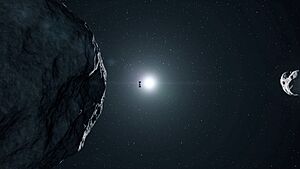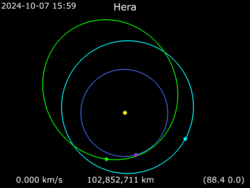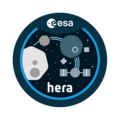Hera (space mission) facts for kids
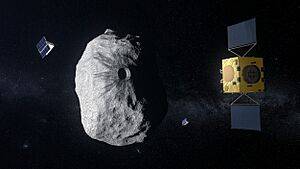
Artist's impression of Hera in orbit around the asteroid Didymos
|
|
| Mission type | Didymos orbiter |
|---|---|
| Operator | European Space Agency |
| Mission duration | 1 year, 2 months, 12 days (elapsed) 2 years, 9 months (planned) |
| Spacecraft properties | |
| Manufacturer | OHB SE |
| Launch mass | 1,128 kg (2,487 lb) |
| Dry mass | 350 kg (770 lb) |
| Dimensions | 1.6 × 1.6 × 1.7 m (5.2 × 5.2 × 5.6 ft) |
| Start of mission | |
| Launch date | 7 October 2024, 14:52:11 UTC (10:52:11 am EDT) |
| Rocket | Falcon 9 Block 5 B1061-23 |
| Launch site | Cape Canaveral, SLC‑40 |
| Contractor | SpaceX |
| Flyby of Deimos | |
| Closest approach | 12 March 2025, 12:07 GMT |
| Distance | 300 km (190 mi) |
| Flyby of Mars | |
| Closest approach | 12 March 2025, 12:51 GMT |
| Distance | 5,000 km (3,100 mi) |
| 65803 Didymos orbiter | |
| Orbital insertion | 14 December 2026 |
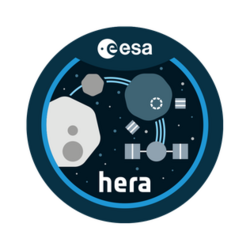 Mission insignia |
|
Hera is a special spacecraft built by the European Space Agency (ESA). Its main job is to study a pair of asteroids called Didymos. These asteroids were hit by another spacecraft, DART, four years ago.
Hera will help scientists learn if we can push a dangerous asteroid away from Earth. It will measure the size of the crater DART made. It will also see how much the asteroid moved after the hit. This helps us understand if hitting an asteroid is a good way to protect our planet.
The Hera spacecraft weighs about 1,128 kilograms (2,487 pounds). It carries special cameras, an altimeter (to measure height), and a spectrometer (to study light). Hera also carries two smaller spacecraft called Milani and Juventas. These small spacecraft are called CubeSats.
Hera launched on October 7, 2024, using a SpaceX Falcon 9 rocket. It is now on its way to study the results of the DART impact. DART hit the smaller asteroid, Dimorphos, on September 27, 2022.
Contents
Why the Hera Mission Matters
The main goal of the Hera mission is to check a method called "kinetic impact." This method involves crashing a spacecraft into an asteroid. The idea is to change the asteroid's path if it ever threatens Earth. This is one of the best ways we know to protect our planet.
To do this, Hera needs to find out:
- How much an asteroid moves depends on its density and what its surface is like.
- How much energy from the crash breaks up the asteroid or sends pieces flying.
Hera also has important science goals. It will gather details about the two asteroids, Didymos and Dimorphos. It will study their surfaces and what they are made of inside. Hera will be the first mission to look deep inside an asteroid. It will use a special radar on the Juventas CubeSat for this.
The mission will map Dimorphos in great detail. It will also get a very accurate idea of Dimorphos's mass. This helps scientists figure out how well the DART impact worked.
Hera also has technology goals. It will test smart software that helps the spacecraft fly safely around the asteroid.
Hera carries two CubeSats that it will release near the asteroid:
- Juventas will measure the asteroid's inside and its gravity. It will also see how the surface reacts if it lands on Dimorphos.
- Milani will collect data on what the asteroid surfaces are made of. It will also look for dust around the asteroids.
How the Hera Mission Started
Working with NASA: The AIDA Project
The AIDA project was the first plan to test how to move asteroids away from Earth. It started in 2013 with scientists from NASA and ESA working together. The plan was to send two spacecraft to the binary asteroid Didymos. NASA's DART spacecraft would crash into the smaller asteroid. ESA's AIM orbiter would then measure the crash effects.
In late 2016, ESA decided not to build AIM. This was because they did not have enough money from member countries. NASA, however, kept working on DART. Ground-based telescopes were planned to help observe the DART impact instead of AIM. Later, DART also included a small satellite called LICIACube. LICIACube was released before the crash to film the first 100 seconds.
Hera Takes Shape
In 2017, some ESA member countries asked for a new mission to replace AIM. This new mission was named Hera, after a Greek goddess. Hera was designed to do all the important jobs that AIM would have done. It would use as many parts from the AIM design as possible.
Hera was planned to launch in October 2024. This timing was important to reach the asteroids and study the DART impact on Dimorphos. The study would happen four years after the DART crash.
The ESA approved the Hera mission in November 2019. In September 2020, ESA hired a group of companies led by OHB to build the spacecraft. The contract was worth 129.4 million euros. The mission team also became official, with scientists guiding all parts of the mission. Hera went through its final tests in March 2024.
The DART Mission
The DART mission launched on November 24, 2021. A Falcon 9 rocket carried it from Vandenberg Space Force Base. DART reached the Didymos asteroid system on September 26, 2022. It crashed into its moon, Dimorphos, at 23:16 UTC. The crash speed was about 6.6 kilometers per second (4.1 miles per second).
Hera Mission Journey
Launch Day
Hera launched on October 7, 2024, at 14:52 UTC. It lifted off from Space Launch Complex 40 (SLC-40) in Florida. The rocket was a Falcon 9. This launch site is usually for Starlink satellites. However, another big mission, Europa Clipper, was getting ready at a different launchpad. So, Hera had to use SLC-40.
The launch happened even though Falcon 9 rockets were temporarily stopped. This was due to a problem with a different mission the month before. But Hera was going far into space, so the rules were changed for its launch. The rocket booster used for Hera had flown 22 times before. It was not reused after this flight. After launching, Hera performed a deep-space maneuver in November 2024.
Mars Flyby
Hera flew past Mars on March 12, 2025. It came within 5,000 kilometers (3,100 miles) of the planet's surface. This close flyby helped Hera get a speed boost from Mars's gravity.
During the flyby, Hera also observed Mars's moon, Deimos. It took pictures from 1,000 kilometers (620 miles) away. Its closest approach to Deimos was 300 kilometers (190 miles). Hera also practiced finding craters on Mars. This helped test its navigation system for flying around asteroids.
Arriving at Didymos
The Hera spacecraft will reach the binary asteroid 65803 Didymos on December 28, 2026. This is four years after the DART impact. Hera will then spend six months studying the asteroids. It will be the first mission to visit a binary asteroid system.
Once Hera is close to Didymos, it will follow five main steps:
| Phase | Mission Step | Time | What Hera Will Do |
|---|---|---|---|
| 1 | Early Characterization | 6 weeks | Measure the shape, mass, and heat of both asteroids. |
| 2 | Payload Deployment | 2 weeks | Release the two small CubeSats. |
| 3 | Detailed Characterization | 4 weeks | Map the asteroids in detail and study their insides. |
| 4 | Close Observation | 6 weeks | Look closely at Dimorphos, including the DART impact crater. |
| 5 | Experimental | 6 weeks | Study Dimorphos's surface, colors, and heat properties. |
Hera Spacecraft Design
The main part of Hera is shaped like a box. It is about 1.6 by 1.6 by 1.7 meters (5.2 by 5.2 by 5.6 feet). It has two solar panels that stick out from its sides. These panels collect sunlight to power the spacecraft. A large dish antenna is on one side for talking to Earth.
When it launched, Hera weighed about 1,214 kilograms (2,676 pounds). It uses special thrusters to move around in space. These thrusters help it change its path and stay pointed in the right direction. Hera talks to Earth using X-band radio waves. It also uses S-band radio waves to talk to its two CubeSats, Juventas and Milani.
Hera Scientific Tools
Hera carries several important tools to study the asteroids.
Asteroid Framing Cameras (AFC)
Hera's main tools are its two AFC cameras. These cameras are identical and work together. They take black and white pictures. They can see details as small as one meter (3.3 feet) from 10 kilometers (6.2 miles) away. These cameras will help map the surfaces of Didymos and Dimorphos. They will also get clear images of the DART crater.
Hyperspectral Imager – HyperScout-H
HyperScout-H is a special camera that sees light in many different colors. It can see light that humans cannot, from visible light to near-infrared. This helps scientists learn what the asteroid surfaces are made of.
Planetary Altimeter (PALT)
PALT is a laser tool that measures height. It sends out a laser beam and measures how long it takes to bounce back. This helps Hera know its exact distance from the asteroid's surface. It can measure height with an accuracy of 0.5 meters (1.6 feet).
Thermal Infrared Imager (TIRI)
TIRI is a camera that sees heat. It was provided by the Japanese space agency, JAXA. It helps scientists understand the temperature of the asteroid surfaces. This can tell them about the materials on the surface.
X-Band Radio Science (X-DST)
Scientists can figure out the mass of the asteroids and their gravity using radio waves. They measure small changes in the radio signals between Hera and Earth. They also use signals between Hera and its CubeSats. These measurements are very important for understanding the asteroids' gravity.
| AFC | HyperScout-H | PALT | TIRI | |
|---|---|---|---|---|
| Type | Visible Camera | Color Camera | Height Measurer | Heat Camera |
| Mass (kg) | <1.5 | 5.5 | 4.5 | <4.4 |
| Power (Watts) | <1.3 | 2.5 (average) | <14.5 | 20 (average) |
Hera's CubeSats
Hera carries two small satellites called CubeSats: Milani and Juventas. Hera will release them before it reaches the Didymos asteroid system. They will do extra studies that help Hera's mission.
Both CubeSats are about 12 kilograms (26 pounds) each. They can move in three directions and have small thrusters. They talk to Hera using S-band radio. The radio link also helps measure the gravity of the asteroid system. They have cameras and star trackers to help them know where they are. Both CubeSats also have accelerometers. These tools will measure the asteroid's surface if the CubeSats land on it at the end of their mission.
Juventas CubeSat
Juventas will study the physical features of Dimorphos. It will map the asteroid's gravity and look at its inside structure. It will also study the surface.
Juventas has these tools:
- The JuRa radar: This is the first tool to look inside an asteroid. It can see details 10 to 15 meters (33 to 49 feet) deep.
- The GRASS gravimeter: This tool measures gravity very precisely.
- A camera.
- Its radio link with Hera: This helps measure the asteroid's gravity.
Milani CubeSat
The Milani CubeSat is named after a mathematician, Andrea Milani. It will take pictures and look for dust around the asteroids. It will map both Didymos and Dimorphos. It will also study their surfaces and the effects of the DART impact. Milani will also help measure gravity and look for dust clouds.
Milani has two main tools:
- The ASPECT hyperspectral imaging spectrometer: This is its main camera. It sees light in many colors, from visible to near-infrared. It can see details as small as 2 meters (6.6 feet) from 10 kilometers (6.2 miles) away.
- The VISTA thermogravimeter: This tool looks for dust, water, and other light materials.
Images for kids
See also
 In Spanish: Hera (sonda) para niños
In Spanish: Hera (sonda) para niños
- Near-Earth Object Coordination Centre (ESA's NEOCC)
- Planetary Defense Coordination Office (NASA's PDCO)
- Double Asteroid Redirection Test (DART mission)
- List of European Space Agency programmes and missions


